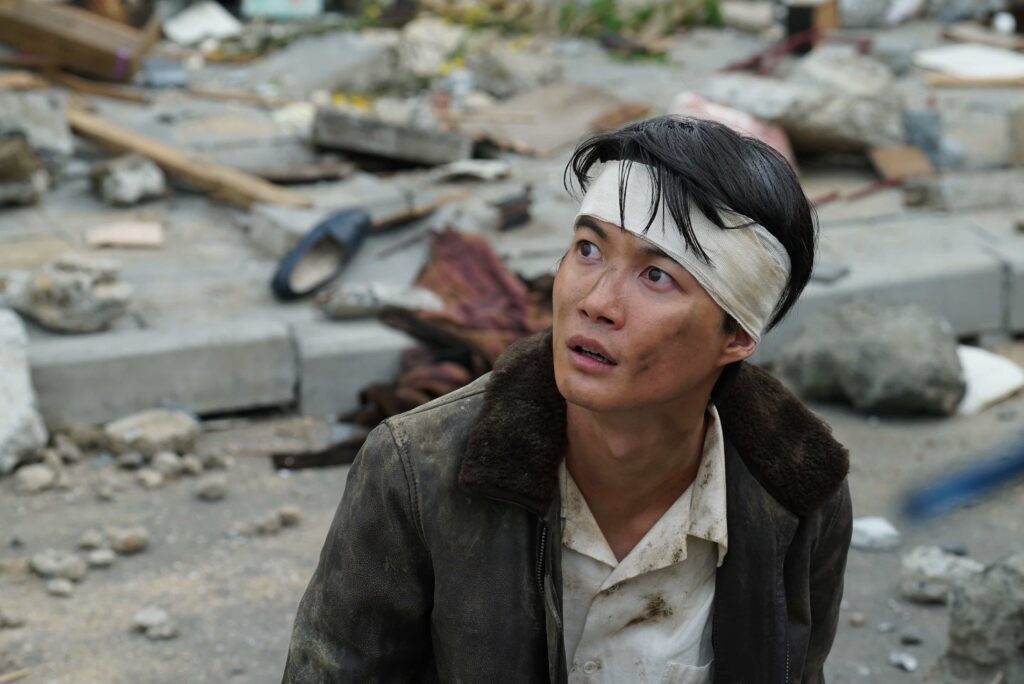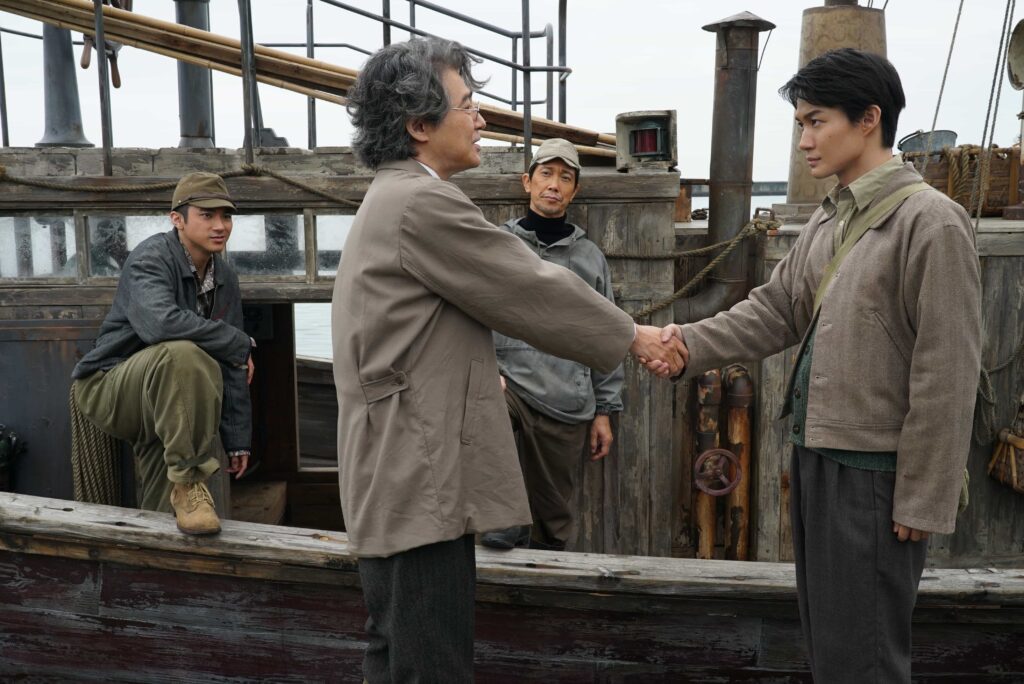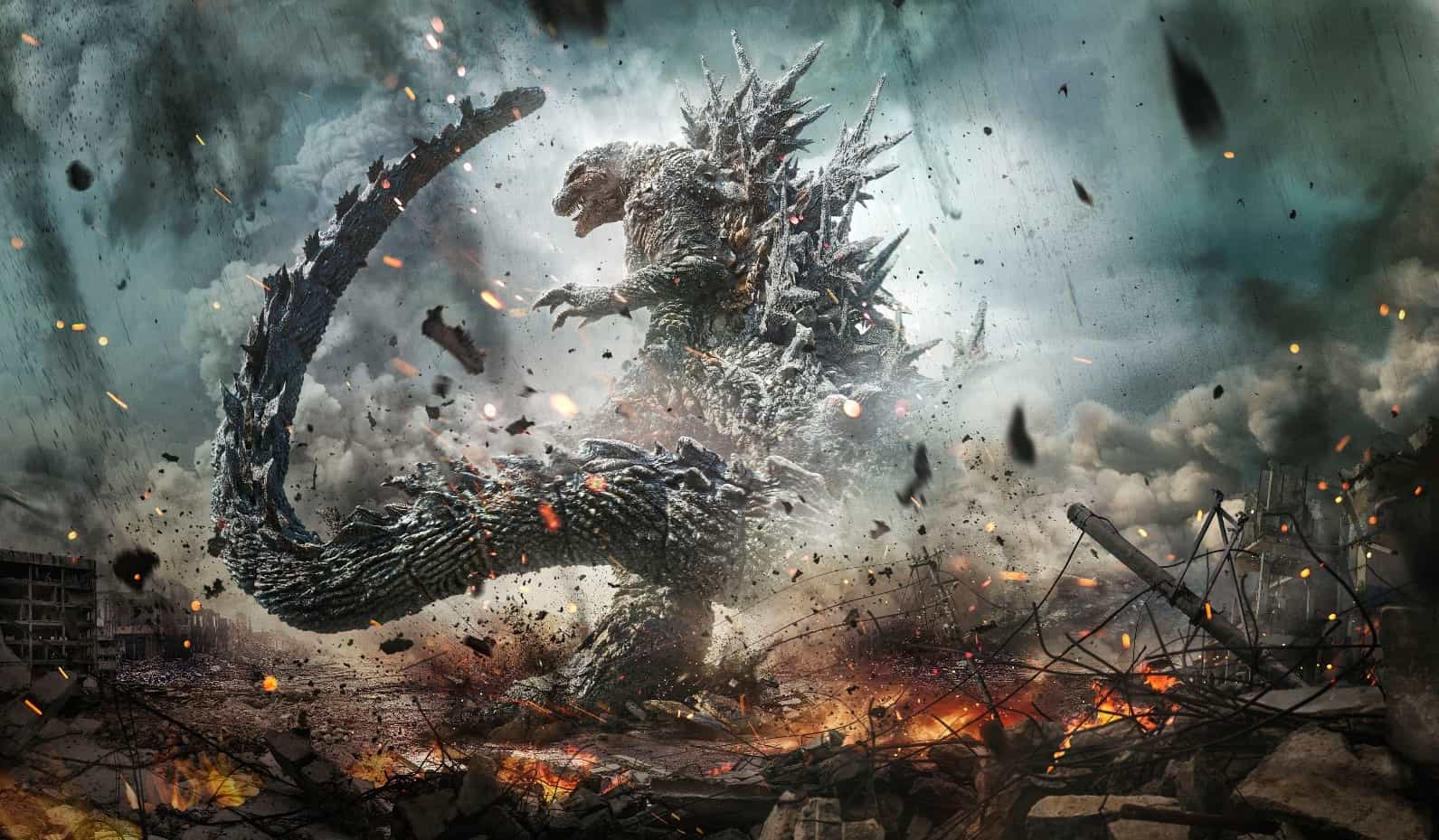This article originally appeared in the April 2024 issue of CONNECT.
Dylan O’Connell (Hyogo)
On a peaceful sunny day in 1946, the minesweeper conducts its patrol in the Pacific Ocean. The vessel’s arm severs the mine’s chain, allowing it to float to the surface. Trainee Shiro Mizushima (Yuki Yamada) attempts to detonate the mine by shooting it with the boat mounted machine gun but fails to connect. Recently hired World War II veteran Koichi Shikishima (Ryunosuke Kamiki) soon takes over and quickly sets some well-placed shots on the mine. However, the crew’s celebration at the explosion is cut short when Mizushima laments his inability to participate in the Greater East Asia War causes Shikishima to silence him. WWII was brutal and young men should not wish to have joined it. Unfortunately, for the crew, the monster Shikishima encountered on a remote Pacific island will soon reemerge to invoke the destruction of war once again.

Godzilla Minus One (ゴジラ -1.0, Yamazaki, 2023) is the first live-action Japanese Godzilla film of the Reiwa era, following Shin Godzilla (シン・ゴジラ, Anno and Higuchi, 2016). And like Shin Godzilla, Godzilla Minus One is a standalone film presenting a story with themes relevant to Japan’s current issues.
Slight disclaimer, I do not understand much Japanese, but the plot of Godzilla Minus One was still easy to follow. Shikishima, an understandably hesitant kamikaze pilot, encounters Godzilla at the end of WWII. His inaction to fight the monster alongside his fellow soldiers and their subsequent deaths leaves him with intense survivor’s guilt. Returning to a post-firebombed Tokyo, Shikishima is joined by the homeless Noriko Oishi (Minami Hamabe) and her rescued adorable, adopted daughter Akiko (Sae Nagatani). However, as Shikishima and his found family tries to rebuild their lives alongside a devastated Japan, a Godzilla mutated by U.S. nuclear testing returns.
Godzilla Minus One seems to react not only to the original 1954’s messaging about nuclear weapons, but also the re-emerging possibility of conflict in the Pacific. (2) Godzilla is once again the product of American nuclear weapons testing, but this time, its atomic breath is capable of similar destruction, perhaps echoing the imagery of an atomic explosion more than any other iteration of the monster. In this way, Godzilla can be viewed as an allegory for the nuclear armed neighbors Japan perceives as national threats from: China, North Korea, and Russia. To counter these threats, the Japanese government is attempting to bolster its Self-Defense Forces, but doing so requires budget and national will. In Godzilla Minus One, Japanese Imperial Navy veterans heed the call for volunteers, even Shikishima. He also inspires the next generation of Japanese young men such as Mizushima, who were spared the horrors of World War II, to do the same. However, the modern Japanese populace is not as eager as their film counterparts.

In a film with themes subtly promoting Japanese military enlistment in the face of nuclear threats, it is a bold choice to also include the personal costs such a decision may reap on a character such as Shikishima. Shikishima provides a strong human foundation to this kaiju film. He is a kamikaze pilot who abandoned his divine mission and is shamed for surviving a war many of his peers did not. (1) His tormented thoughts and trauma are realistically portrayed in his moments of PTSD. He struggles to open up with his friends, lashes out at his family, and awakens from nightmares in cold sweats. Godzilla may be a seemingly all-powerful force, but through Shikishima’s eyes, the kaiju is his personal tormentor.
It is interesting to note the ever-diverging depictions of Godzilla between America and Japan. As the Legendary Pictures version drifts more into the WWE style monster mashup reminiscent of the Japanese Showa Era films, the latest live-action Japanese films cement themselves in the culture moment. For example, Shin Godzilla was critical of the Japanese government’s response to the Fukushima disaster. (7) This is historical precedent for such divergence as well. The original 1954 film had 20 minutes cut, an American character included, and was retitled Godzilla, King of the Monsters! (3) The American edit added insinuations of native sacrifices to Godzilla reminiscent of King Kong and removed direct references to nuclear weapons to suit entertainment and political appetites. Annoyingly, it was a massive success. Though the 2014 American Godzilla hinted at such nuclear concerns, those references became increasingly mute in sequels. (4) The American Godzilla’s metaphor never captures the same apocalyptic intensity as the Japanese’s. (6)

Finally, despite costing a fraction of a fraction of the cost of the average American Godzilla film, Godzilla Minus One outdoes them in visual splendor. Godzilla’s appearances may be sparse, but that gives them added weight when they do occur. This iteration may not be a man in a suit, but its visual fidelity echoes that origin much to its benefit. See Godzilla Minus One in theaters if you ever get the chance!
For more Godzilla experiences off the silver screen, visit Godzilla the Ride and Nijigen no Mori. Godzilla the Ride is an awesome simulated ride located at Seibu-en outside Tokyo and it was created by the director of Godzilla Minus One, Takashi Yamazaki. At the Nijigen no Mori theme park on Awaji Island, there is a Shin Godzilla zipline.
Source List
- Britannica: Casualties of World War II
- Godzilla Minus One (ゴジラ -1.0). Directed by Takashi Yamazaki, Toho, 2023.
- Godzilla, King of the Monsters! Directed by Terry O. Morse and Ishirō Honda, Trans. World Releasing Corp., 1956.
- Godzilla. Directed by Gareth Edwards, Legendary Pictures, 2014.
- Godzilla Minus One is About Trauma & Hope
- Monarch: Legacy of Monsters Explores Godzilla’s Twin Heritages
- Shin Godzilla (シン・ゴジラ). Directed by Hideaki Anno and Shinji Higuchi, Toho, 2016.
Dylan O’Connell is a third-year ALT from the U.S. who is currently working at two senior high schools in Kita-Harima. A film studies graduate, he is enamored with Japanese culture. When not preaching the good word about Godzilla, he may be found studying Japanese or writing about other media on his blog Dylan O’Connell’s Writing Corner.




